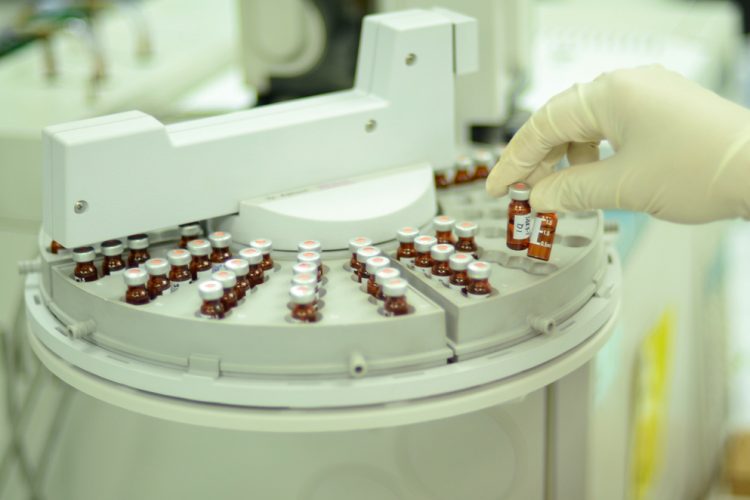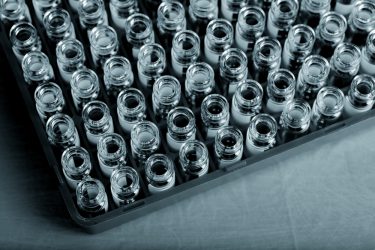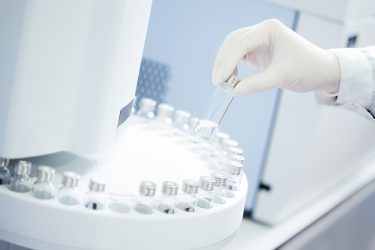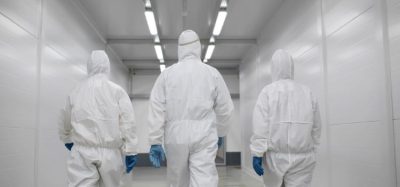How is liquid chromatography used in the pharmaceutical industry?
Posted: 2 April 2020 | Victoria Rees (European Pharmaceutical Review) | No comments yet
Liquid chromatography is an analytical technique utilised widely in the pharmaceutical industry. How does it work and what other methods can it be combined with to enhance its uses?


In the pharmaceutical industry, all manufactured products need to be of the highest quality to ensure the least risk to patients. To guarantee that goods pass certain standards, researchers, manufacturers and developers use various technical equipment and analytical techniques, including liquid chromatography, during the development process.


The mixed components are placed at the top of the column of the stationary phase, which is generally a fine adsorbent solid such as silica. This must be distributed evenly to minimise the presence of air bubbles that could influence the results of the test. The exit of the column is stoppered with glass, wool or a porous plate. When the mobile phase passes through, the mixture separates into bands. These can then be collected and analysed via other methods.1
The technique works as the components in a mixture are attracted to the adsorbent surface of the stationary phase with varying degrees depending on their individual polarity and their unique structural characteristics; a component with a higher affinity for the stationary phase will migrate down the column slower than a component which has more affinity for the mobile phase.
The most common form of liquid chromatography in use today is high-performance liquid chromatography (HPLC), which pumps the sample mixture through the column at high pressure.
How is liquid chromatography used in pharma?
HPLC is the form of liquid chromatography that is generally used in the pharmaceutical industry, as it can provide the precise results that are required. The results can be used to analyse finished drug products and their ingredients quantitatively and qualitatively during the manufacturing process. This is achieved through the separation, quantification and identification of components in a mixture and can be used to reveal the identity of a drug and monitor the progress of a therapy on a disease.2
…HPLC is simple, specific, rapid, precise and accurate”
Although expected at first to be used as a complimentary method to gas chromatography, the pharmaceutical industry now almost exclusively uses HPLC as a chromatographic technique.2
One of the main benefits of HPLC is its ability to elucidate the structure and determine the quantities of impurities in pharmaceutical formulations.3 HPLC is especially suitable for compounds that are not easily volatilised, thermally unstable and have high molecular weights. Therefore, it can quantify a drug in its pure and dosage form.
Other forms of HPLC that are used in the pharmaceutical industry include reversed-phase, denaturing and immobilised enzyme reactor (IMER) HPLC.4
However, one of the disadvantages of HPLC is that is must be preceded by calibration tests which can increase costs.4
Combining analytical techniques


HPLC-UV uses UV as a form of detection. The advantage of this is that it does not require the elaborate treatment and procedures usually associated with the traditional chromatographic method,5 making it less time consuming and economical.
However, some components may have weak UV chromophores if UV detection is being used or be completely retained on the liquid chromatography column. For the detection of the components, a diode array and rapid scanning detector are useful for peak identification and for the monitoring of peak purity. Instead, fluorescence and electrochemical detectors are considerably more sensitive towards appropriate analytes and more selective than UV detectors for many compounds.2
According to Nikolin et al., the most sensitive method for HPLC detection is reductive electrochemical detection, which has yielded excellent results in the investigation on some classes of drugs.2
Another technique that HPLC can be combined with is mass spectrometry (HPLC/MS); the chromatograph is attached via an interface to a mass spectrometer. This form of analysis can examine a wide range of components, including those that are thermally labile, exhibit high polarity or have a high molecular mass. The components eluted from the column are introduced to the mass spectrometer on the specialised interface. The two most common interfaces used for HPLC/MS are electrospray ionisation and atmospheric pressure chemical ionisation interfaces.6
Summary
Liquid chromatography is a useful analytical tool for establishing the components of a drug’s formulation, enabling researchers to quantify the formulation and discover whether there are any impurities in a product.
The other techniques that HPLC can be combined with further its capabilities, making it an ideal analytical technique for pharma to ensure the high quality of drugs.
References
- Chemistry LibreTexts. 2020. Chromatography. [online] Available at: https://chem.libretexts.org/Bookshelves/Analytical_Chemistry… [Accessed 2 April 2020].
- Nikolin B e. High perfomance liquid chromatography in pharmaceutical analyses. – PubMed – NCBI [Internet]. Ncbi.nlm.nih.gov. 2020 [cited 2 April 2020]. Available from: https://www.ncbi.nlm.nih.gov/pubmed/15629016
- [Internet]. Longdom.org. 2020 [cited 2 April 2020]. Available from: https://www.longdom.org/open-access/hplc-uses…
- Liquid Chromatography News, Research [Internet]. News-Medical.net. 2020 [cited 2 April 2020]. Available from: https://www.news-medical.net/?tag=/Liquid-Chromatography
- Chromatography Conferences 2020 | HPLC Conferences 2020 | Pharmaceutical Chemistry Conferences | Meetings | Events | 2020 | Europe USA Asia [Internet]. Chromatography.pharmaceuticalconferences.com. 2020 [cited 2 April 2020]. Available from: https://chromatography.pharmaceuticalconferences.com/
- Bristol University – High Performance Liquid Chromatography Mass Spectrometry (HPLC/MS) [Internet]. Bris.ac.uk. 2020 [cited 2 April 2020]. Available from: http://www.bris.ac.uk/nerclsmsf/techniques/hplcms.html









